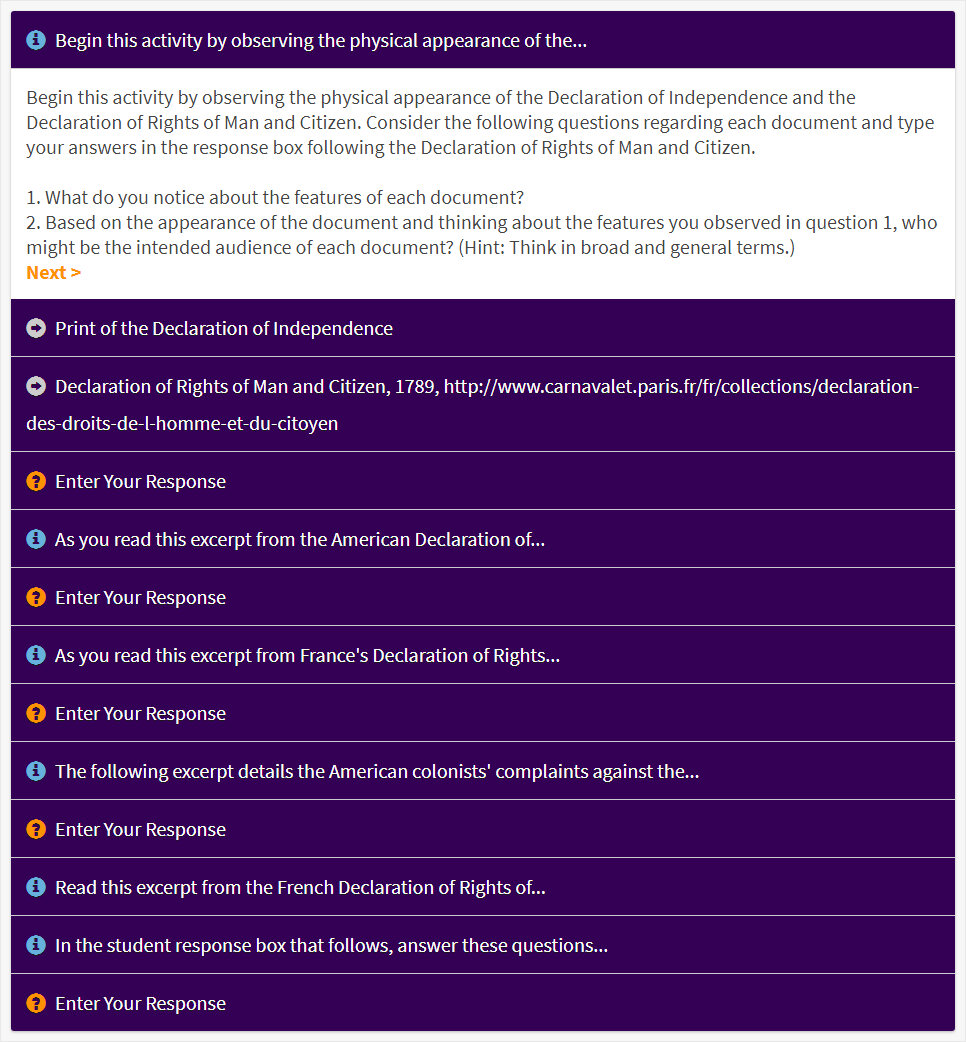This activity engages students in a comparison of the American Declaration of Independence and the French Declaration of Rights of Man and Citizen. Students will focus on analyzing message, purpose, and audience. Students should complete the activity with an understanding that while the ideals underlying the two documents were very similar, the purpose and audience of the two documents differed significantly.
Suggested Teaching Instructions
This activity is intended for students in grades 9-12 and should take approximately one class period. Translations of the Declaration of Rights of Man and Citizen are provided by the
Avalon Project at Yale University.
Begin by asking students what rights Americans have. Possible answers will include liberty, speech, fair and speedy trial, etc. Next, ask them where these rights come from. Explain to students that ideas of individual rights came from a French movement called the Enlightenment that influenced the Atlantic revolutions of the eighteenth and nineteenth centuries. Both of the declarations featured in this activity were inspired by the ideals of the Enlightenment.
Direct students to the activity. Explain that they will focus on comparing and contrasting the Declaration of Independence from the USA and the Declaration of Rights of Man and Citizen from France. They will begin with a visual analysis of the documents. Students may be concerned because the visual document for Declaration of Rights of Man and Citizen is in French, but reassure them that they will not need to read the document in the visual analysis (they will read translated excerpts of it later in the activity); for the visual analysis students just need to focus on the appearance of the document.
Encourage students to work with a partner or a small group as they analyze the documents and address the questions. Peer support will likely help them gain a better understanding of the texts. Ask students to complete the visual analysis portion of the activity. When they have finished, process the following questions from the activity as a whole class:
1. What do you notice about the features of each document?
2. Based on the appearance of the document and focusing on the features you observed in question 1, who might be the intended audience of each document? (Think in broad, general terms)
Students may notice that the Declaration of Independence has signatures, similar to a petition, so perhaps the people who signed it are petitioning for something from an individual or a group. They may notice that the Declaration of Rights of Man and Citizen has multiple parts. It also has artwork, possibly signifying that it is a formal document intended for a public audience.
Move students on to the second part of the activity, where they will analyze excerpts from the introductory portions of the documents. After they have completed the second set of analyses, process the questions as a whole class:
1. What are two main ideas from each excerpt?
2. What is one purpose of each excerpt?
Now ask students to work with their partner or group to find some similarities and differences between the excerpts of the two documents; after a few minutes ask students to share with the whole class.
Finally, ask students to move on to the final analysis set: excerpts from the body of the two documents. After they have completed the analysis, process the discussion questions as a class:
1. What do the documents tell us about how America and France felt about individual rights?
2. Who is the "he" in the Declaration of Independence and why is "he" significant?
3. What is the purpose of each excerpt?
Ask students to work with their partner or group to find some similarities and differences between the excerpts of the two documents; after a few minutes ask students to share with the whole class.
Once students have completed the document analysis and you have processed it as a class, direct students to the "When you're done" section.
This activity was created by National Archives intern and social studies teacher Leah Bouas.




